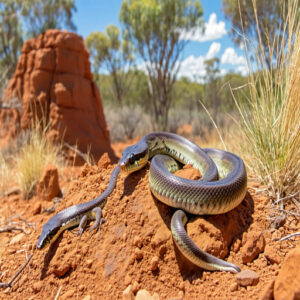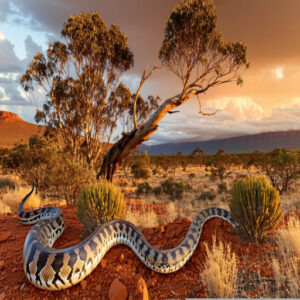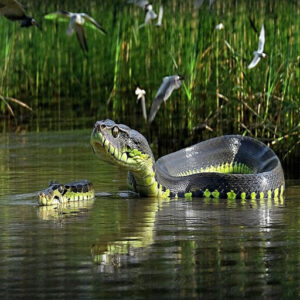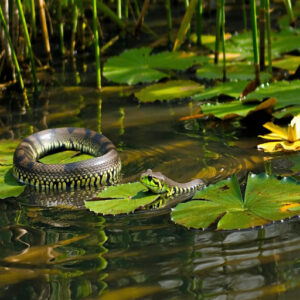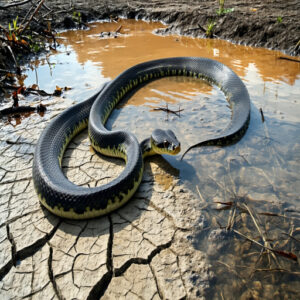This site is supported by our readers. We may earn a commission, at no cost to you, if you purchase through links.

You’ll find these adaptable reptiles in Africa’s savannas, Asia’s lush forests, and even Australia’s coastal areas.
Each species, like the ball python in Africa or the reticulated python in Southeast Asia, carves a niche in habitats ranging from dense jungles to open grasslands.
Some, like the green tree python, even take to the trees.
They thrive in warm climates but show impressive adaptability, handling everything from deserts to wetlands.
Unfortunately, habitat loss and invasive populations, like Burmese pythons in Florida, threaten ecosystems.
Curious how they navigate these challenges?
There’s more to uncover!
Table Of Contents
- Key Takeaways
- Global Distribution of Python Snake Species
- Python Snakes in Africa
- Asian Habitats and Python Snake Populations
- Python Snake Distribution in Australia
- Factors Influencing Python Snake Distribution Patterns
- Invasive Python Snake Populations
- Urban and Suburban Python Snake Adaptation
- Aquatic Habitats and Python Snake Distribution
- Future Trends in Python Snake Distribution
- Frequently Asked Questions (FAQs)
- What is the distribution of the python snake?
- How much does Florida pay for captured pythons?
- What is the Burmese pythons current distribution?
- Where do python snakes live?
- How are Python snakes classified?
- What is a python snake?
- Are there pythons in Africa?
- How big is a python snake?
- Where are pythons most commonly found?
- Do pythons stay in one area?
- Conclusion
Key Takeaways
- You’ll find pythons thriving in diverse habitats worldwide, from African savannas to Southeast Asian forests and Australian coasts, showcasing their impressive adaptability.
- Habitat loss, climate change, and invasive populations like Burmese pythons in Florida threaten ecosystems and challenge the survival of these adaptable snakes.
- Pythons adapt to different environments, including deserts, wetlands, and urban areas, by leveraging unique traits like heat-sensing pits and camouflage skills.
- Conservation efforts, such as habitat restoration and wildlife management, are crucial for protecting python populations and the ecosystems they help balance.
Global Distribution of Python Snake Species
You’ll find python snakes thriving across continents, from Africa’s savannas to Southeast Asia’s dense forests and even Australia’s coastal regions.
Their adaptability lets them occupy an impressive variety of habitats, making them one of the most widespread snake families on the planet.
Geographic Range of Python Snakes
Where do python snakes live?
The python snake distribution spans jungles, savannas, and forests, reaching from Southeast Asia to Sub-Saharan Africa.
These adaptable serpents slither through climate zones with ease, thriving in diverse habitats.
However, habitat fragmentation and python migration sometimes mean unplanned visits to human spaces, leaving you wondering if these territorial giants have pushed too far into our world.
Species Diversity Across Continents
Across continents, python snake distribution highlights fascinating continental variations tied to geographic isolation and biodiversity hotspots.
- Africa: The ball python thrives, popular for its docile nature.
- Asia: Dense jungles shelter the mighty reticulated python.
- Australia: The carpet python adapts gracefully to fragmented habitats.
These species, shaped by habitat fragmentation and species migration, showcase remarkable adaptability across Africa, Asia, and Australia.
Habitat Types Occupied by Pythons
Pythons are true survivalists, thriving from rocky outcrops to dense forests and even swamp environments.
Their astounding adaptability means you might spot them in deserts or gracefully traversing wetland waters.
These reptiles embrace diverse habitats, showcasing unparalleled versatility.
Here’s a closer look:
| Habitat Type | Python Species | Notable Trait |
|---|---|---|
| Desert Ecosystems | Ball Python | Heat Adaptation |
| Forest Habitats | Green Tree Python | Arboreal Mastery |
| Grassland Ecology | Burmese Python | Ground Maneuverability |
| Swamp Environments | African Rock Python | Aquatic Proficiency |
Whether scaling trees or sliding through grasslands, pythons harmonize with their environment effortlessly.
Climate Preferences of Python Species
You’d be amazed at how python species adapt to various climate zones, thriving where others might fail.
Their preferences revolve around:
- Temperature tolerance that helps them survive extremes.
- Humidity levels shaping rainforest and savanna ecosystems.
- Thermal regulation via sunny basking or burrowed cooling.
- Geographic migration, shifting ranges due to climate change.
This adaptability secures their place across diverse regions despite habitat loss threatening python ecology globally.
Python Snakes in Africa
You’ll find some of the world’s most fascinating python species across Africa, from the iconic African rock python to the smaller ball python.
These snakes thrive in diverse habitats, ranging from arid savannas to dense rainforests, each playing a critical role in their ecosystems.
African Python Species and Subspecies
The African Python species showcase incredible diversity within their genus.
Take the African rock python (Python sebae), a giant in the snake world, expertly adapted to taking down large prey.
The smaller, adaptable Southern African rock python (P. natalensis) even nests in termite mounds.
These reptiles display awe-inspiring behaviors and remarkable survival tactics, emphasizing the importance of protecting their unique snake habitats through species conservation efforts.
For more information on snake identification, visit resources that can help with distinguishing between similar species, such as the African Rock python, and understand their habitats and behaviors to aid in conservation.
Distribution Patterns in Sub-Saharan Africa
Picture Sub-Saharan Africa as a varied mosaic—picturing python distribution here mirrors its diversity.
Africa’s python snake distribution ranges from the sultry tropical regions to savannah ecology and even harsh desert habitats.
Species like P. sebae thrive in semi-arid zones, while Ball Pythons roam grasslands.
Climate shifts and habitat fragmentation twist their range shifts, cementing wildlife conservation as a pressing need.
Ecological Niches of African Pythons
African pythons like the African rock python showcase incredible adaptability across diverse habitats.
Whether in desert habitats, savannah ecology, or tropical forests, they fit right in.
These stealthy hunters thrive in their ecological niche, despite habitat fragmentation.
- Ambush prey in grassland dynamics or rocky outcrops.
- Hunt birds, mammals, and reptiles.
- Blend into surroundings flawlessly.
- Resist environmental changes with ease.
- Avoid predators and humans alike.
Conservation Status of African Python Populations
Pythons across Africa face serious hurdles, like habitat loss and illegal trade, sparking fears of species extinction.
Conservation efforts are tackling these challenges head-on, working to stabilize population dynamics and safeguard their ecosystems.
For example, the African rock python, an emblem of python snake distribution, needs protected habitats.
By preserving their spaces, we’re securing these incredible reptiles’ future.
| Threat | Impact on Pythons |
|---|---|
| Habitat Loss | Reduced living space |
| Illegal Trade | Overexploitation |
| Climate Change | Shrinking habitats |
| Hunting Pressure | Declining populations |
| Urban Expansion | Displacement of species |
Asian Habitats and Python Snake Populations
You’ll find python snakes thriving across Asia, from the dense rainforests of Southeast Asia to the dry scrublands of the Indian subcontinent.
These adaptable reptiles have mastered a variety of ecosystems, using their stealth and hunting skills to make each region their own.
Python Species Native to Asia
Asia is home to python species that thrive in diverse habitats, from forests to grasslands.
You’ll find the Indian python, a master of camouflage, and the Burmese python, a formidable swimmer.
Understanding snake habitat is essential for conservation efforts.
- Their role in the Asian snake trade
- Adaptations to Asian Python Habitats
- Stealthy hunting skills
- Important roles in ecosystems
- Endangered by habitat loss
Range of Pythons in Southeast Asia
Southeast Asian pythons, including the famed Burmese and reticulated species, call lush tropical forests, bustling island habitats, and humid wetlands home.
Their python migration patterns highlight remarkable adaptability within shared spaces like New Guinea and the Moluccas.
However, python snake distribution faces threats like habitat loss and poaching.
Snake conservation remains pivotal, ensuring their mesmerizing presence doesn’t vanish from Southeast Asia’s rich species diversity and evolving range shifts.
Indian Subcontinent Python Distribution
The Indian Subcontinent hosts a fascinating blend of python species, including Himalayan Pythons and Desert Pythons, thriving across mountain ecosystems, dense forests, and arid landscapes.
Indian Species like the Indian rock python adapt to fragmented habitats remarkably well.
However, python snake distribution relies heavily on habitat preservation and prey abundance.
Protecting Subcontinent Habitats remains key to maintaining species distribution amidst growing human pressures and environmental changes.
Adaptations to Asian Ecosystems
Asian ecosystems push pythons to evolve remarkable tricks. They excel in snake camouflage, blending effortlessly into tropical forests. Heat-sensing pits act like night-vision goggles in dense foliage.
These python snake adaptations support balance across diverse habitats.
Here’s how they do it:
- Masterful mimicry of leaves and branches.
- Specialized diets fitting habitat diversity.
- Climate resilience for shifting ranges.
- Ambushing prey with precision.
- Balancing prey populations, safeguarding ecosystem health.
Python Snake Distribution in Australia
In Australia, pythons thrive in a variety of habitats, from humid coastal forests to dry inland regions.
You’ll find species like the carpet python and olive python uniquely adapted to this diverse landscape, showcasing their resilience and versatility.
Endemic Australian Python Species
Australia’s pythons are masters of adaptation, blending perfectly into their unique habitats.
Here are three endemic python species:
- Woma Python: Camouflage expert roaming arid zones, notable for missing heat-sensing pits.
- Pygmy Python: Tiny termite-mound dweller, proving size isn’t everything.
- Amethystine Python: Northern giant with shimmering scales, mesmerizing yet elusive.
These species highlight the beauty of Australian Python Habitats while inspiring Python Conservation Efforts and global Reptile Research.
Coastal Vs Inland Python Populations
Coastal habitats give pythons lush jungles and abundant prey—think rodents, birds, and more.
Inland ecosystems? They’re harsher, with scarce food and blazing heat shaping survival.
Ever wonder where pythons are found? Along coastlines, human encroachment changes shoreline ecology, while inland, it’s the wild terrain dictating python distribution.
These snakes adapt like wanderers, adjusting to sea level shifts and arid lands. Python snake habitats showcase incredible resilience and geographic range diversity!
Unique Adaptations to Australian Environments
They’re masters of desert survival, thriving where some can’t.
With clever snake camouflage, Australian pythons disappear into arid and tropical habitats. Hunting mostly at night, they sidestep scorching daytime heat, proving their environmental resilience.
These python snake adaptations to the environment include:
- Blending seamlessly into dry outback backdrops.
- Effortless heat regulation, outsmarting harsh climates.
- Adaptable movement, traversing coastal, forested, and dry regions with ease.
Impact of Climate on Python Distribution
Recent studies show Australian pythons face unprecedented climate shifts, with temperature effects reshaping their distribution patterns.
Rising temperatures and altered weather patterns force these remarkable reptiles to adapt or relocate.
As a result, climate change impacts are now being observed in their behavior and habitats, making conservation efforts more essential.
| Climate Factor | Impact on Python Distribution |
|---|---|
| Temperature Rise | Earlier emergence from hiding |
| Rainfall Changes | Habitat loss and range shifts |
| Sea Level Rise | Coastal habitat compression |
| Seasonal Timing | Modified breeding cycles |
| Resource Access | Altered prey availability |
Like skilled acrobats, these adaptable creatures navigate their changing world, but habitat loss and ecological impact test their resilience as never before.
Factors Influencing Python Snake Distribution Patterns
You’ll find that python snakes choose their homes based on several key factors, including temperature, food supply, and hiding places that keep them safe from predators.
Whether you’re tracking pythons in steamy tropical rainforests or arid savannas, you’ll notice these remarkable reptiles have adapted to survive in places where they can find enough prey and maintain their preferred body temperature, which is a crucial factor for their survival in places where they can find enough prey.
Environmental Factors Affecting Python Habitats
Responding to nature’s delicate rhythms, python snakes rely on precise environmental factors to establish their homes.
Temperature fluctuations drive their daily patterns, while soil quality and water cycles shape their habitat choices.
As urbanization intensifies, habitat fragmentation threatens the ecosystem balance these adaptable reptiles depend on.
From dense vegetation to varied terrain, pythons navigate a complex web of conditions that determine their distribution across landscapes, influenced by temperature fluctuations.
Prey Availability and Python Distribution
When prey is abundant, python snake distribution closely follows their prey base, maximizing food supply.
They thrive in rich habitats, creating a delicate ecological balance.
Limited food or habitat loss may force migrations, affecting population dynamics.
- Dense prey base attracts pythons to specific areas.
- Habitat shifts align with food sources.
- Diverse prey availability expands their range.
Impact of Human Activities on Python Ranges
Your actions could make or break a python’s home.
Human impact, like urbanization destroying habitats or introducing invasive species, has led to significant habitat loss and disrupted python snake distribution.
Rapid urban sprawl carves up green spaces, forcing pythons into smaller, unsuitable areas.
Invasive species steal resources or create competition, making survival even tougher for native pythons.
Pollution poisons water and food supplies, while hunting threatens already fragile populations.
Want to help?
Advocate for green spaces, report invasive species or poaching, and ditch habits that harm ecosystems.
Even small steps, like using eco-friendly products, can support thriving python habitats amidst human-altered landscapes.
Climate Change Effects on Python Populations
Rising temperatures and sea level rise are shaking up python snake distribution.
As climate change pushes them toward cooler areas, many face habitat loss, shrinking ranges, and declining prey.
Understanding tropical rainforest ecosystems is essential for addressing these issues.
Some, like the Burmese python, become invasive species, creating new ecological impacts.
These snakes, now unpredictable climate refugees, need targeted conservation to stop population decline while managing their expanding presence.
Invasive Python Snake Populations
You’ve probably heard about pythons popping up where they don’t belong, like the massive Burmese pythons wreaking havoc in Florida’s Everglades.
These invasive populations upset local ecosystems by preying on native wildlife and competing with top predators, creating serious ecological challenges.
Introduced Python Species in Non-Native Habitats
Exotic pythons in non-native habitats can wreak havoc like uninvited guests crashing a fragile ecosystem.
These alien reptiles—like invasive Burmese pythons—spark habitat disruption and outcompete native species. Their spread, often tied to the pet trade, spells trouble.
Effective python traps are essential in controlling invasive python populations.
- What drives it? Careless pet releases.
- Impacts: Ecosystem imbalance, habitat loss.
- Ecosystem disruption: Top predator role.
- Control: Management strategies critical.
Case Study: Burmese Pythons in Florida
The Burmese python invasion in Florida is a snake saga that keeps twisting.
These massive, invasive species thrive in the Everglades’ warm, swampy paradise, a habitat mirroring their tropical roots.
With no natural predators, it’s like an endless buffet for these apex hunters.
It’s bad news for Florida’s ecosystem—raccoons, opossums, and even bobcats are vanishing faster than the last donut at a meeting.
Their breeding? Legendary.
A single female can lay up to 100 eggs, making population control feel like an endless uphill climb.
And their stealth? Exceptional.
Their patterned scales let them vanish into the Everglades’ dense terrain like a magician’s disappearing act.
Here’s why it matters:
- Severe loss of native mammals due to Burmese impact.
- Increased predator competition altering the Florida ecosystem.
- Detection is a nightmare in the Everglade invasion.
- Rapid breeding accelerates snake migration and expansion.
Ecological Impact of Invasive Python Snakes
When invasive species like Burmese pythons slither in, they wreak havoc.
These giants outcompete native wildlife, causing devastating ecological damage. In areas like the Everglades, mammals such as raccoons and bobcats are vanishing, throwing the entire ecosystem balance into chaos.
Habitat disruption is rampant, making snake control essential. The spread of these predators highlights urgent conservation efforts to safeguard fragile habitats.
Management Strategies for Invasive Python Populations
Florida’s scaly squatters call for action! Top strategies include population control methods like ethical captures and removals, habitat restoration techniques to deter breeding, and public-backed wildlife management policies.
These strategies are crucial as they tackle invasive species and aim at restoring balance. Events like the Python Challenge boost community involvement,
while conservation efforts focus on rebalancing ecosystems, and spotlighting wildlife conservation as a shared mission, utilizing these management strategies.
Urban and Suburban Python Snake Adaptation
You mightn’t expect it, but some python species have adapted surprisingly well to urban and suburban areas, often finding shelter in parks, gardens, and even beneath buildings.
These adaptable reptiles face unique challenges in human-dominated landscapes, balancing survival against habitat loss and frequent encounters with people.
Python Species Thriving in Human-Dominated Landscapes
Pythons have taken to city life like pros, thriving in fragmented habitats caused by urbanization destroying ecosystems.
These urban python adaptations help manage pests but spark human-wildlife conflict.
Similar snake adaptations are seen in suburban areas, detailed on this snake habitat webpage.
Living proof of nature’s resilience, they slither through altered landscapes with ease.
Conservationists now explore wildlife coexistence strategies, merging landscape ecology with sustainable practices to balance python snake distribution and urban ecosystems.
Challenges and Opportunities in Urban Environments
Urban pythons navigate a unique world, balancing survival with thriving in human-dominated landscapes.
Challenges spring from urbanization destroying habitats, while adaptive strategies open doors.
Think:
- Urban Wildlife: Rodents galore, but prey scarcity lingers.
- Shelter Spots: City planning often leaves scarce hideouts.
- Python Snake Conservation Status: Essential to balance delicate ecosystems.
- Snake Encounters: Human conflict rises, sparking invasive species management.
Human-Python Conflicts in Populated Areas
Living near pythons often sparks human-wildlife conflict, especially as urbanization destroys habitats.
Urban encounters with pythons—whether invasive species or escaped pets—can lead to risks like python attacks.
Snake removal efforts sometimes escalate fear rather than resolve issues, effective conflict resolution balances human safety and python snake conservation status, respecting these adaptable creatures while protecting neighborhoods.
Conservation Efforts in Urban Python Habitats
As urbanization destroys, conservation efforts focus on balancing city life with wildlife management.
Here’s how you can support python snake distribution in cities: Effective urban python conservation requires a multifaceted approach.
- Habitat Restoration: Build green spaces and wildlife corridors.
- Urban Planning: Design areas promoting ecosystem services.
- Community Awareness: Host workshops addressing human-wildlife conflict.
- Innovative Solutions: Embrace tech like snake-tracking apps to guarantee coexistence.
Small actions bring big change!
Aquatic Habitats and Python Snake Distribution
You’ll find certain python species thriving near rivers, lakes, and wetlands, where water plays a key role in their survival.
These adaptable snakes, like the water python, have unique traits for semi-aquatic lifestyles, allowing them to flourish in habitats rich with prey and moisture.
Python Species Associated With Water Bodies
Water Python Habitats are like thriving playgrounds in aquatic habitats.
From wetlands to riverine ecosystems, these semi aquatic reptiles embrace freshwater snakes’ skills to hunt and survive.
Check out this quick breakdown:
| Feature | Habitat Example | Benefit to Pythons |
|---|---|---|
| Wetlands | Marshes, swamps | Rich prey availability |
| Rivers | Riverbanks | Steady water supply |
| Coastlines | Mangroves | Sheltered environments |
| Floodplains | Seasonal wetlands | Diverse hunting grounds |
Nature’s efficiency at its best, showcasing semi aquatic reptiles in their natural habitats!
Adaptations for Semi-Aquatic Lifestyles
Semi-aquatic lifestyles demand unique water adaptations, and pythons don’t disappoint.
Their snake physiology shifts to thrive in aquatic habitats like wetlands and river systems.
Key traits include:
- Valvular nostrils: Perfect for staying submerged without inhaling water.
- Paddle-shaped tails: Built for powerful aquatic hunting and swift movement.
- Cutaneous respiration: Allows wetland survival by holding breath longer underwater.
For enthusiasts of semi aquatic gear, these adaptations are essential for understanding python behavior.
Talk about evolution diving deep!
Distribution Along River Systems and Wetlands
Pythons thrive in riverine ecosystems and wetland habitats, blending into lush surroundings while hunting fish, frogs, and birds.
Their skill in traversing aquatic corridors empowers them to expand through floodplain dynamics with ease.
Here’s a quick look:
| Feature | Role | Example |
|---|---|---|
| Vegetation camouflage | Protection and hunting aid | Wetlands of Southeast Asia |
| Seasonal flooding | Territory expansion | Florida Everglades |
| Interconnected waterways | Seamless movement | Southern African python distribution |
These masters of adaptation dominate river systems worldwide!
Impact of Water Availability on Python Ranges
Life near water shapes python habitats more than you’d think.
When rivers shrink or wetlands vanish, so does their lifeline. Water sources keep python migration ticking, pushing these semiaquatic reptiles into unexpected places.
They’ve mastered aquatic adaptations, slipping through riverine ecology like pros.
With hydrological cycles shifting, competition for surviving habitats tightens. Pythons? They’re finding every drop to stay ahead.
Future Trends in Python Snake Distribution
You’re likely to see pythons showing up in unexpected places as climate change alters their preferred habitats and prey availability.
Scientists predict these snakes may expand into new regions while facing threats like habitat loss and shifting ecosystems.
Predicted Range Shifts Due to Climate Change
Climate shifts are turning python snake distribution into a game of survival.
Rising temperatures drive habitat loss, forcing pythons to leave familiar ecosystems for cooler, shrinking ranges.
With range contraction and ecosystem disruption, these movements may outpace species adaptability.
Conservation strategies must address temperature effects and protect fragile habitats before climate change tightens the noose on these snakes’ survival.
Potential Expansion Into New Habitats
With changing conditions shaking things up, python snakes could explore new territories thanks to habitat shifts and climate effects.
But it’s not all smooth scales; invasive species and habitat modification might slow their roll.
Here’s how range expansion could unfold:
- Warmer climates may push species migration to higher altitudes.
- Urban areas could offer surprising habitats.
- Conservation efforts can curb ecological impacts.
The potential for range expansion is an important consideration in understanding how these factors interplay to affect the snakes’ habitat and behavior.
Threats to Current Python Snake Distributions
Python snakes face growing threats from habitat destruction, human-wildlife conflicts, and environmental degradation.
Deforestation wipes out essential habitats, while climate shifts challenge their survival.
Poaching for skin and meat adds to their struggles. Invasive species, like the Burmese python in Florida, disrupt ecosystems where they don’t belong.
Additionally, understanding snake shedding problems is vital for maintaining healthy python populations in captivity, which can inform conservation efforts.
Each threat intertwines, creating a dangerous spiral that reshapes python populations and their ecological impact, highlighting the need to address human-wildlife conflicts and environmental degradation to protect these species.
Conservation Strategies for Maintaining Python Habitats
Keeping python habitats intact isn’t just about saving snakes; it’s about maintaining ecosystem balance and biodiversity protection.
Restoring damaged environments, like Florida’s Everglades, helps support both python survival and countless interconnected species.
Controlled breeding programs can guarantee healthy python populations while easing pressure on wild habitats.
Laws protecting pythons from habitat destruction and illegal hunting strengthen long-term species conservation efforts.
Engaging communities is equally important.
Nobody wants a python in their backyard, but understanding their role in the ecosystem changes perspectives.
- Restore habitats: Replant native vegetation and protect wetlands.
- Boost monitoring: Track python snake distribution to identify risks.
- Educate locally: Foster community-led conservation.
- Enforce protections: Strengthen wildlife preservation policies.
Frequently Asked Questions (FAQs)
What is the distribution of the python snake?
Imagine weaving through thick jungles or sunlit savannas—these are python territories.
They stretch across sub-Saharan Africa, southern Asia, Southeast Asia, and Australia, adapting to deserts, forests, and wetlands with remarkable ease.
How much does Florida pay for captured pythons?
Florida pays python hunters up to $13 per hour and bonuses of $50 to $200 per python based on its length.
It’s part of efforts to control invasive Burmese pythons in the Everglades ecosystem.
What is the Burmese pythons current distribution?
The Burmese python, like a stealthy invader, dominates Florida’s Everglades.
It thrives in Southeast Asia, and adapts to tropical forests, grasslands, and wetlands, even pushing into new territories as climate change reshapes global ecosystems.
Where do python snakes live?
Python snakes make their homes across Africa, Asia, and Australia, thriving in jungles, savannas, forests, and even deserts.
They’re highly adaptable, blending effortlessly into their surroundings, whether near water or deep within dense vegetation.
How are Python snakes classified?
You’d classify python snakes under the family Pythonidae, within reptiles (class Reptilia), order Squamata, and suborder Serpentes.
They’ve got 8 genera, 32 species, and fascinating traits like paired lungs and heat-sensing pits.
What is a python snake?
A python is a non-venomous snake known for its incredible size, impressive strength, and ability to constrict prey.
Found in diverse habitats, it’s a top-tier predator with sharp senses and fascinating adaptations.
Are there pythons in Africa?
Under Africa’s blazing suns and sprawling landscapes, you’ll find pythons thriving in diverse habitats like savannas, forests, and rocky outcrops.
They’re masters of survival, blending seamlessly with their surroundings to hunt mammals and birds, and utilizing their adaptability as pythons.
How big is a python snake?
Some pythons stay small, around 5 feet,
while giants like the reticulated python can stretch over 20 feet.
Think of them as nature’s size spectrum—from manageable to “Wait, it’s how long?!”
Where are pythons most commonly found?
Imagine a hidden traveler traversing diverse terrains—pythons thrive in Africa’s sun-baked savannas, Asia’s tropical forests, and Australia’s wild landscapes.
You’ll find them blending into these habitats, from dense jungles to open woodlands near water.
Do pythons stay in one area?
Pythons aren’t known for roaming far.
They tend to stay in one area as long as there’s food, shelter, and the right temperature.
However, habitat changes or food scarcity can push them to move.
Conclusion
Much like a puzzle, python snake distribution reveals a fascinating picture of adaptability and diversity across the globe.
These reptiles thrive in warm climates, occupying habitats ranging from African savannas to Southeast Asian rainforests and Australian coasts.
However, threats like habitat loss, invasive populations, and climate change challenge their survival.
By understanding their habitats, species variations, and conservation needs, you can contribute to preserving these remarkable creatures and the ecosystems they’re so deeply woven into.







